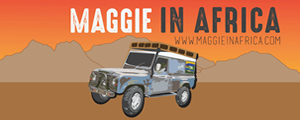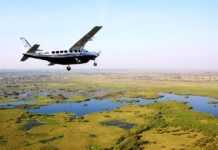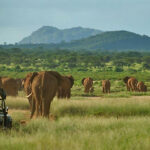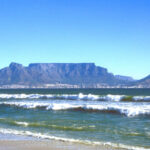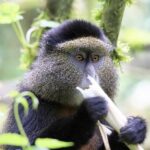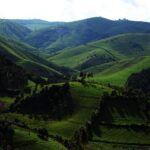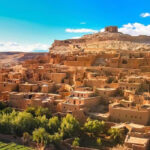Written by our dear friend David Franco in Botswana, in August & September 2014:
It’s around noon and Noel and Marilu meet us at the entrance of the Khama Rhino Sanctuary. They woke up at 5:30 to join us in time to drive in convoy to Kubu Island, in the Sua Pan. Maggie seems to be in good shape and the sight of the coloured paintings on her sides makes me happy.
After greeting each other and planning the route in our large maps displayed on top of the landies, we set out on our journey.
The drive to Kubu Island is the most beautiful one can ever experience: off-roading across the largest network of pans in the world, blinded by the whiteness of the soil and covered in dust from the salty tracks. Right in front of us, Maggie drives through the immensity, taking deep dives into dusty, rocky, and uneven roads. The sight of the Defender emerging from a cloud of dust is spectacular, a true gift.
We are completely alone in this timeless landscape. Suddenly, a lone ostrich appears out of nowhere and runs next to us for a couple of miles. I ask myself how any form of life can survive in this part of the world. We arrive at our destination around sunset, a little later than planned but right in time for a good dinner.
As we drive closer, the island slowly rises from the immensity and emptiness of the Sua Pan to present itself as a floating, giant Baobab. Hundreds of them, of all sizes and shapes, greet us as we find our camping spot. Meanwhile, the starred sky illuminates and reminds us of our humble place in the universe. This place is simply magical, indeed one can hardly imagine any other place in the world with the same splendour.
We wake up at 5:45 and gear up in readiness for the sunrise, which according to our Garmin will happen at exactly 6:27. We walk alongside and across part of the island looking for a privileged spot from which to witness and observe the awakening of the day. I observe amused the hundreds of Baobabs that populate this mysterious island. Some are loners, standing in complete isolation on top of a rocky hill, while others seem to be part of a family of trees. Some look majestic, others look weaker and in need of support.
We keep on walking until we find an ideal location. We stand there, still and motionless, as we observe the giant red disk rising from behind the timeless line that separates the end of the pan from the roof of the earth. It is an incredible sight, unique, very difficult to describe. I cannot think of a place on earth more raw and earthly.
Back on the road, we head to Gabatsadi Island located on the neighbouring Ntwetwe Pan, south of the legendary Chapman’s Baobab. The day rewards us with yet another incredible journey across all types of terrain including endless pans, the savannah, and the bush. The Savannah is yellow and the grass is tall, burying part of the Defender and adding to the mysticalness of this beautiful land.
We drive for seven hours and realise that we will not make it to Gabatsadi Island before sunset, so we decide to set up camp by the Chapman Baobab, a millenary multi-trunk tall baobab that owes its name to the 19th century British explorer. The tree is simply stunning. It is located next to a local farm so we spend a good part of the evening battling tens of annoying flies.
Suddenly, life works its magic and as the sun sets behind the bush the flies start dissipating, leaving us with the company of our fire and the millions of twinkling stars. Time is a mysterious concept and nowhere else have I become more aware of its relativity.
